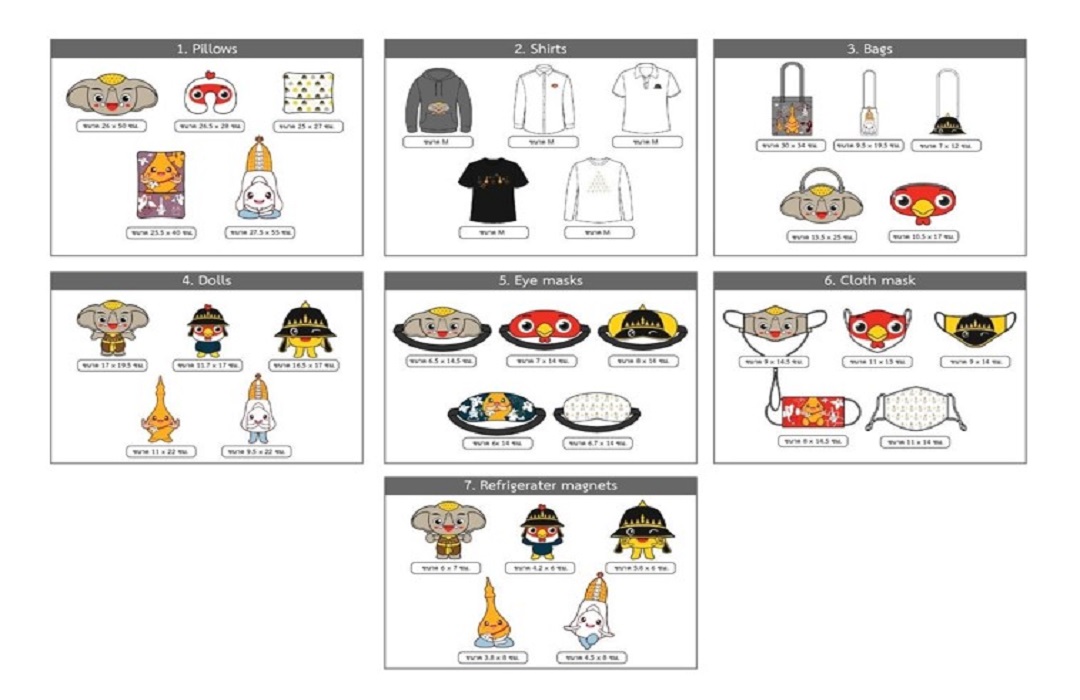The Design of Souvenir Products Presented through Augmented Reality for the King Naresuan Exhibition and Convention Center
DOI:
https://doi.org/10.69650/ahstr.2024.2273Keywords:
Augmented reality, Souvenir Products, King Naresuan Exhibition and Convention Center, Phitsanulok ProvinceAbstract
The purposes of this research were 1) to study and analyze souvenir products for the King Naresuan Exhibition and Convention Center, 2) to design those souvenir products presented through augmented reality (AR) technology, and 3) to assess consumer satisfaction with the design of those souvenir products presented through AR technology. The study was conducted in two phases. In Phase 1, the researchers collected preliminary data by reviewing documents, theories, and research related to the design of souvenir product identities and visiting museums in Phitsanulok and Bangkok to create a questionnaire for use in assessing the needs identified by the research sample group. The data that were obtained were used for designing and creating the sketches of souvenir products, including the designed cartoon characters (a total of 40 patterns). These sketches were assessed using an assessment form and chosen by the experts in the field of souvenir product design. The chosen sketches were then used as prototypes for actual production in the next phase. In Phase 2, the five selected cartoon characters were used to produce the prototypes of souvenir products that could be presented through AR technology. The user could use his/her smart devices (e.g., a phone or a tablet) that had the NUsouvenirs application installed, to scan the souvenir products. The story and history of the King Naresuan Exhibition and Convention Center were presented. The souvenir products’ design as presented through AR technology was then assessed by the experts in the field of AR design and by the research sample group. The results showed that the design of the products, and the satisfaction with this AR experience and this AR application, were suitable for use in terms of uniqueness, design, usability, and suitability for being sold in stores. The AR technology was shown to be effective in promoting visitor involvement by purchasing souvenir products and gaining AR experience. Suggestions gained from the study and suggestions for further research are also discussed.
References
Agag, G., Shehawy, Y.M., Almoraish, A., Eid, R., Lababdi, H.C, Labben, T.G., & Abdo, S.S. (2024). Understanding the relationship between marketing analytics, customer agility, and customer satisfaction: A longitudinal perspective. Journal of Retailing and Consumer Services, 77, 1- 14. https://doi.org/10.1016/j.jretconser.2023.103663
Apte, S., Mainkar, M., & Ransing, R. (2021). Augmented reality museum. Journal of Emerging Technologies and Innovative Research (JETIR), 8(5), d753-d762.
Bird, J. M., Smart, P. A., Harris, D. J., Phillips, L. A., Giannachi, G., & Vine, S. J. (2023). A magic leap in tourism: Intended and realized experience of head-mounted augmented reality in a museum context. Journal of Travel Research, 62(7), 1427– 1447. https://doi.org/10.1177/00472875221134031
Cooper, E. (2023). Extended reality--applications in vision science and beyond: Improving augmented reality through perceptual science. Journal of Vision, 23(15). https://doi.org/10.1167/jov.23.15.15
Department of Industrial Promotion. (2023, May 16). Souvenirs: Cultural and artistic products. https://www.dip.go.th/th/category/2020-06-24-19-46-47/2020-06-24-19-47-45
Forster, H. I. (2018). Opportunities to utilize the potential of augmented reality to interact with photographic material in museums. [Master’s thesis]. Ryerson University.
Ghandour, A., Kintonova, A., Demidchik, N., & Sverdlikova, E. (2021). Solving tourism management challenges by means of mobile augmented reality applications. International Journal of Web-Based Learning and Teaching Technologies, 16(6), 1-16. https://doi.org/10.4018/IJWLTT.293280
Jin, Y., Ma, M., & Liu, Y. (2024). Comparative study of HMD-based virtual and augmented realities for immersive museums: User acceptance, medium, and learning. Journal on Computing and Cultural Heritage, 17(1), 1– 17. https://doi.org/10.1145/3627164
Jondya, A. G., Saputro, D. P., Sungkharisma, L. C. (2022). Pengembangan Aplikasi Augmented Reality “eMuseum” dengan Metode Agile untuk Meningkatkan Pengalaman Pengunjung Museum. Journal of Information System Research (JOSH), 3(4), 483-489. https://doi.org/10.47065/josh.v3i4.1746
Jongsriratanakul, J. (2017). Selecting cartoon characters for brand communication in service businesses [Master’s thesis]. Bangkok University.
Liang, S. (2015). Research proposal on reviewing augmented reality applications for supporting ageing population. Procedia Manufacturing, 3, 219 – 226. https://doi.org/10.1016/j.promfg.2015.07.132
Mamee, W., & Chuenchaichon, C. (2024). Cartoon Character Design for the King Naresuan Exhibition and Convention Center. Art and Architecture Journal Naresuan University, 15(1), 226-243.
Ministry of Social Development and Human Security (2022, May 12). Five-year government operational plan (2023 - 2027) https://www.m-society.go.th/ewtadmin/ewt/mso_web/download/article/article_20220909164426.pdf
National Science Museum (2022, March 10). What are AR and VR? and how are they different? https://www.nsm.or.th/nsm/th/node/4327
Phitsanulok Province ( 2022, April 12) . Development strategies for Phitsanulok province in 11 areas. https://www.phitsanulok.go.th/yuthasat/plan61_65.pdf
Purnomo, F. A., Santosa, P. I., Hartanto, R., Pratisto, E. H., & Purbayu, A. (2018). Implementation of augmented reality technology in Sangiran Museum with Vuforia. In: IOP Conf. Series: Materials Science and Engineering 333 (2018) 012103. https://doi.org/10.1088/1757-899X/333/1/012103
Tarafdar, P., Leung, A. C., Yue, W. T., & Bose, I. (2024). Understanding the impact of augmented reality product presentation on diagnosticity, cognitive load, and product sales. International Journal of Information Management, 75, 1-15. https://doi.org/10.1016/j.ijinfomgt.2023.102744
Tourism Authority of Thailand (2022, September 5). Popular secondary cities. http://tourismlibrary.tat.or.th/ medias/T26966.pdf
Wu. C., Lin, Y., Peng, K., & Liu, C. (2023). Augmented reality marketing to enhance museum visit intentions.
Journal of Hospitality and Tourism Technology, 14(2), 658-674. https://doi.org/10.1108/JHTT-052022-0129
Yan, H., Wang, J., & Zhang, P. (2023). Application of optimized ORB algorithm in design AR augmented reality technology based on visualization. Mathematics, 11(6), 1278. https://doi.org/10.3390/math11061278

Downloads
Published
How to Cite
Issue
Section
License
Copyright (c) 2024 Asian Health, Science and Technology Reports

This work is licensed under a Creative Commons Attribution-NonCommercial 4.0 International License.













